Extent of Cropland and Related Soil Erosion Risk in Rwanda
Abstract
:1. Introduction
2. Materials and Methods
2.1. Study Area
2.2. Datasets and Methodology
2.2.1. Land Cover and Land Use Map of Rwanda
2.2.2. The RUSLE Model
Rainfall Erosivity (R) Factor
Soil Erodibility (K) Factor
Slope Length and Steepness (LS) Factor
Cover Management (C) Factor
Support Practice (P) Factor
2.2.3. Model Application
3. Results
3.1. Assessment of Land Cover and Land Use in Rwanda
3.2. The Soil Erosion in Rwanda
4. Discussion
5. Conclusions
Acknowledgments
Author Contributions
Conflicts of Interest
Abbreviations
| ft | foot |
| ha | hectare |
| h | hour |
| MJ | megajoule |
| mm | millimeter |
| t | ton [38] |
| a | year |
| km | kilometer |
| RWF | Rwandan Franc |
| $ | U.S. dollar |
References
- Oldeman, L. The global extent of soil degradation. Soil Resil. Sustain. Land Use 1994, 9, 99–118. [Google Scholar]
- Lindquist, E.J.; D’annunzio, R.; Gerrand, A.; Macdicken, K.; Achard, F.; Beuchle, R.; Brink, A.; Eva, H.D.; Mayaux, P.; San-Miguel-Ayanz, J.; et al. Global Forest Land-Use Change 1990–2005; Fao Forestry Paper No. 169; Food and Agriculture Organization of the United Nations and European Commission Joint Research Centre: Rome, Italy, 2012. [Google Scholar]
- Van Straaten, P. Rocks for Crops: Agrominerals of Sub-Saharan Africa; ICRAF: Nairobi, Kenya, 2002; Volume 407, p. 338. [Google Scholar]
- Grimm, M.; Jones, R.; Montanarella, L. Soil Erosion Risk in Europe. 2001. Available online: http://citeseerx.ist.psu.edu/viewdoc/download?doi=10.1.1.397.2450&rep=rep1&type=pdf (accessed on 27 June 2016).
- Tamene, L.; Le, Q.B. Estimating soil erosion in sub-Saharan Africa based on landscape similarity mapping and using the revised universal soil loss equation (RUSLE). Nutr. Cycl. Agroecosyst. 2015, 102, 17–31. [Google Scholar] [CrossRef]
- Montgomery, D.R. Soil erosion and agricultural sustainability. Proc. Natl. Acad. Sci. USA 2007, 104, 13268–13272. [Google Scholar] [CrossRef] [PubMed]
- Alkharabsheh, M.M.; Alexandridis, T.; Bilas, G.; Misopolinos, N.; Silleos, N. Impact of land cover change on soil erosion hazard in northern Jordan using remote sensing and GIS. Proced. Environ. Sci. 2013, 19, 912–921. [Google Scholar] [CrossRef]
- Cebecauer, T.; Hofierka, J. The consequences of land-cover changes on soil erosion distribution in Slovakia. Geomorphology 2008, 98, 187–198. [Google Scholar] [CrossRef]
- Szilassi, P.; Jordan, G.; Van Rompaey, A.; Csillag, G. Impacts of historical land use changes on erosion and agricultural soil properties in the Kali Basin at Lake Balaton, Hungary. Catena 2006, 68, 96–108. [Google Scholar] [CrossRef]
- Bakker, M.M.; Govers, G.; Kosmas, C.; Vanacker, V.; Van Oost, K.; Rounsevell, M. Soil erosion as a driver of land-use change. Agric. Ecosyst. Environ. 2005, 105, 467–481. [Google Scholar] [CrossRef]
- United Nation. World Population Prospects: The 2015 Revision. Population Division. 2015. Available online: http://esa.un.org/unpd/wpp/ (accessed on 25 October 2015).
- De la Paix, M.J.; Lanhai, L.; Jiwen, G.; de Dieu, H.J.; Gabriel, H.; Jean, N.; Innocent, B. Radical terraces in Rwanda. East Afr. J. Sci. Technol. 2012, 1, 53–58. [Google Scholar]
- Habiyaremye, G.; Jiwen, G.; de la Paix Mupenzi, J.; Balogun, W.O. Demographic pressure impacts on forests in Rwanda. Afr. J. Agric. Res. 2011, 6, 4533–4538. [Google Scholar]
- EDPRS. Economic Development and Poverty Reduction Strategy II, 2013–2018: Shaping Our Development. Available online: http://www.minecofin.gov.rw/index.php?id=149 (accessed on 20 October 2015).
- Twagiramungu, F. Environmental Profile of Rwanda; Consultancy Report; European Commission: Kigali, Rwanda, 2006; p. 78. [Google Scholar]
- UNEP. Rwanda State of Environment and Outlook: Our Environment for Economic Development. Available online: http://www.unep.org/publications/contents/pub_details_search.asp?ID=4089 (accessed on 20 October 2015).
- Murekatete, E. Controls of Denitrification in Agricultural Soils, Wetlands, and Fish Ponds in the Migina Catchment, Rwanda; Unesco-IHE: Delft, The Netherlands, 2013. [Google Scholar]
- Nachtergaele, F.O.; Petri, M.; Biancalani, R.; van Lynden, G.; van Velthuizen, H.; Bloise, M. GLADIS Global Land Degradation Information System—Beta version: Report and methods information document. September 2011. Available online: http://www.fao.org/nr/lada/index.php?option=com_content&view=article&id=161&Itemid=113&lang=en (accessed on 15 October 2015).
- Lewis, L.A.; Clay, D.C.; Dejaegher, Y.M. Soil loss, agriculture, and conservation in Rwanda: Toward sound strategies for soil management. J. Soil Water Conserv. 1988, 43, 418–421. [Google Scholar]
- Clay, D.C.; Lewis, L.A. Land use, soil loss, and sustainable agriculture in Rwanda. In Case Studies in Human Ecology; Springer: New York, NY, USA, 1996; pp. 271–287. [Google Scholar]
- Claessens, L.; Van Breugel, P.; Notenbaert, A.; Herrero, M.; Van De Steeg, J. Mapping potential soil erosion in East Africa using the Universal Soil Loss Equation and secondary data. IAHS Publ. 2008, 325, 398–407. [Google Scholar]
- Oppong, J.R. Rwanda-Juvenile Literatue. I. Title. II. Series; Infobase Publishing: New York, NY, USA, 2009. [Google Scholar]
- AFDB. African Statistical Yearbook 2015. Available online: http://www.afdb.org/en/knowledge/publications/african-statistical-yearbook/ (accessed on 18 June 2015).
- Meigh, J.; McKenzie, A.; Sene, K. A grid-based approach to water scarcity estimates for eastern and southern Africa. Water Resour. Manag. 1999, 13, 85–115. [Google Scholar] [CrossRef]
- USGS, Earth Resources Observation and Science Center (EROS). U.S. Geological Survey global visualization viewer. Available online: http://glovis.usgs.gov/index.shtml (accessed on 20 September 2015).
- Basnet, B.; Vodacek, A. Tracking land use/land cover dynamics in cloud prone areas using moderate resolution satellite data: A case study in central Africa. Remote Sens. 2015, 7, 6683–6709. [Google Scholar] [CrossRef]
- Otukei, J.R.; Blaschke, T. Land cover change assessment using decision trees, support vector machines and maximum likelihood classification algorithms. Int. J. Appl. Earth Observ. Geoinform. 2010, 12, S27–S31. [Google Scholar] [CrossRef]
- Richards, J.; Jia, X. Remote Sensing Digital Image Analysis; Springer: New York, NY, USA, 1999. [Google Scholar]
- Thomlinson, J.R.; Bolstad, P.V.; Cohen, W.B. Coordinating methodologies for scaling landcover classifications from site-specific to global: Steps toward validating global map products. Remote Sens. Environ. 1999, 70, 16–28. [Google Scholar] [CrossRef]
- Anderson, J.R. A Land Use and Land Cover classIfication System for Use with Remote Sensor Data; US Government Printing Office: Washington, DC, USA, 1976; Volume 964.
- Manandhar, R.; Odeh, I.O.; Ancev, T. Improving the accuracy of land use and land cover classification of Landsat data using post-classification enhancement. Remote Sens. 2009, 1, 330–344. [Google Scholar] [CrossRef]
- Mather, P.M. Computer Processing of Remotely-Sensed Images, 3rd ed.; Wiley: Chichester, UK, 2004. [Google Scholar]
- RCMRD. Land Cover Viewer: Eastern & Southern Africa. Available online: http://apps.rcmrd.org/landcoverviewer/ (accessed on 20 October 2015).
- Long, J.B.; Giri, C. Mapping the Philippines’ mangrove forests using Landsat imagery. Sensors 2011, 11, 2972–2981. [Google Scholar] [CrossRef] [PubMed]
- Huang, C.; Goward, S.N.; Masek, J.G.; Thomas, N.; Zhu, Z.; Vogelmann, J.E. An automated approach for reconstructing recent forest disturbance history using dense Landsat time series stacks. Remote Sens. Environ. 2010, 114, 183–198. [Google Scholar] [CrossRef]
- Congalton, R.G. A review of assessing the accuracy of classifications of remotely sensed data. Remote Sens. Environ. 1991, 37, 35–46. [Google Scholar] [CrossRef]
- Bishop, Y.; Fienberg, S.; Holland, P. Discrete Multivariate Analysis: Theory and Practice; Massachusetts Institute of Technology Press: Cambridge, MA, USA, 1975. [Google Scholar]
- Renard, K.G.; Foster, G.; Weesies, G.; McCool, D.; Yoder, D. Predicting Soil Erosion by Water: A Guide to Conservation Planning with the Revised Universal Soil Loss Equation (RUSLE); United States Department of Agriculture: Washington, DC, USA, 1997; Volume 703.
- Angima, S.; Stott, D.; O’neill, M.; Ong, C.; Weesies, G. Soil erosion prediction using RUSLE for central Kenyan highland conditions. Agric. Ecosyst. Environ. 2003, 97, 295–308. [Google Scholar] [CrossRef]
- Lu, D.; Li, G.; Valladares, G.; Batistella, M. Mapping soil erosion risk in Rondonia, Brazilian Amazonia: Using RUSLE, remote sensing and GIS. Land Degrad. Dev. 2004, 15, 499–512. [Google Scholar] [CrossRef]
- Nam, P.T.; Yang, D.; Kanae, S.; OKI, T.; Musiake, K. Global soil loss estimate using RUSLE model: The use of global spatial datasets on estimating erosive parameters. Geol. Data Process. 2003, 14, 49–53. [Google Scholar] [CrossRef]
- Fathizad, H.; Karimi, H.; Alibakhshi, S.M. The estimation of erosion and sediment by using the RUSLE model and RS and GIS techniques (Case study: Arid and semi-arid regions of Doviraj, Ilam province, Iran). Int. J. Agric. Crop Sci. 2014, 7, 303–314. [Google Scholar]
- Yu, B.; Rosewell, C. A robust estimators of the R-reaction for the universal soil loss equation. Trans. ASAE 1996, 39, 559–561. [Google Scholar] [CrossRef]
- Renard, K.G.; Freimund, J.R. Using monthly precipitation data to estimate the R-factor in the revised USLE. J. Hydrol. 1994, 157, 287–306. [Google Scholar] [CrossRef]
- Wischmeier, W.H.; Smith, D.D. Predicting rainfall erosion losses—A guide to conservation planning. In Predicting Rainfall Erosion Losses—A Guide to Conservation Planning; USDA, Science and Education Administration: Hyattsville, MD, USA, 1978; p. 62. [Google Scholar]
- Ganasri, B.; Ramesh, H. Assessment of soil erosion by RUSLE model using remote sensing and GIS—A case study of Nethravathi Basin. Geosci. Front. 2015. [Google Scholar] [CrossRef]
- Kim, J.B.; Saunders, P.; Finn, J.T. Rapid Assessment of Soil Erosion in the Rio Lempa Basin, Central America, Using the Universal Soil Loss Equation and Geographic Information Systems. Environ. Manag. 2005, 36, 872–885. [Google Scholar] [CrossRef] [PubMed]
- Biswas, S.S.; Pani, P. Estimation of soil erosion using RUSLE and GIS techniques: A case study of Barakar River basin, Jharkhand, India. Model. Earth Syst. Environ. 2015, 1, 1–13. [Google Scholar] [CrossRef]
- Shin, G. The Analysis of Soil Erosion Analysis in Watershed Using GIS. Ph.D. Thesis, Department of Civil Engineering, Gang-Won National University, Chuncheon, Korea, 1999. [Google Scholar]
- RNRA. Rwanda Natural Resources Authority. National Land Use Planning Portal. Administrative Boundaries. Available online: https://rwandalanduse.rnra.rw/index.php?id=38 (accessed on 15 August 2015).
- Nachtergaele, F.O.; Petri, M.; Biancalani, R.; van Lynden, G.; van Velthuizen, H.; Bloise, M. Global Land Degradation Information System (GLADIS). An Information Database for Land Degradation Assessment at Global Level. Available online: http://www.fao.org/nr/lada/gladis/gladis_db/ (accessed on 15 October 2015).
- NOAA-ESRL Physical Sciences Division, Boulder, Colorado. Global Precipitation Climatology Centre (GPCC): GPCC Global Precipitation Climatology Centre Monthly Precipitation Dataset from 1901-Present Is Calculated from Global Station Data. Available online: http://www.esrl.noaa.gov/psd/ (accessed on 10 January 2015).
- Kagabo, D.; Stroosnijder, L.; Visser, S.; Moore, D. Soil erosion, soil fertility and crop yield on slow-forming terraces in the highlands of Buberuka, Rwanda. Soil Tillage Res. 2013, 128, 23–29. [Google Scholar] [CrossRef]
- Carcamo, J.A.; Alwang, J.; Norton, G.W. On-site economic evaluation of soil conservation practices in Honduras. Agric. Econ. 1994, 11, 257–269. [Google Scholar] [CrossRef]
- Briggs, D.; Giordano, A.; Cornaert, M.; Peter, D.; Maes, J. Corine Soil Erosion Risk and Important Land Resources in the Southern Regions of the European Community. 1992. Available online: http://www.eea.europa.eu/publications/COR0-soil (accessed on 27 June 2016).
- Sylvie, N. An Assessment of Farmers’ willingness to Pay for the Protection of Nyabarongo River System, Rwanda. Master’s Thesis, University of Nairobi, Nairobi, Kenya, November 2012. [Google Scholar]
- Lal, R. Soil degradation by erosion. Land Degrad. Dev. 2001, 12, 519–539. [Google Scholar] [CrossRef]
- Akıncı, H.; Özalp, A.Y.; Turgut, B. Agricultural land use suitability analysis using GIS and AHP technique. Comput. Electron. Agric. 2013, 97, 71–82. [Google Scholar] [CrossRef]
- Bizoza, A.R. Institutions and the adoption of technologies: Bench terraces in Rwanda. In Challenges and Opportunities for Agricultural Intensification of the Humid Highland Systems of Sub-Saharan Africa; Springer International Publishing: Cham, Switzerland, 2014; pp. 335–354. [Google Scholar]
- Mupenzi, J.; Jiwen, G.; Habiyaremye, G.; Mkukakayumba, U. Impact of radical terraces on environment: A case of Kaniga sector in Gicumbi District/Rwanda. Int. J. Sustain. Sci. Stud. 2009, 1, 67–72. [Google Scholar]
- Ke, C.; Feng, Z.; Wu, X.; Tu, F. Design principles and engineering samples of applying vetiver ecoengineering technology for steep slope and riverbank stabilization. In Proceedings of the 3rd International Conference on Vetiver, Guangzhou, China, 6–9 October 2003; China Agricultural Press: Beijing, China, 2003; pp. 365–374. [Google Scholar]
- Kelley, H.W. Keeping the Land Alive: Soil Erosion—Its Causes and Cures; Food & Agriculture Organization: Rome, Italy, 1983. [Google Scholar]
- Zhao, G.; Mu, X.; Wen, Z.; Wang, F.; Gao, P. Soil erosion, conservation, and eco-environment changes in the loess plateau of China. Land Degrad. Dev. 2013, 24, 499–510. [Google Scholar] [CrossRef]
- Syvitski, J.P.; Vörösmarty, C.J.; Kettner, A.J.; Green, P. Impact of humans on the flux of terrestrial sediment to the global coastal ocean. Science 2005, 308, 376–380. [Google Scholar] [CrossRef] [PubMed]
- Bizoza, A.R.; Havugimana, J.M. Land use consolidation in Rwanda: A case study of Nyanza district, Southern province. Int. J. Sustain. Land Use Urban Plan. (IJSLUP) 2013, 1, 64–75. [Google Scholar]
- Bizoza, A.; De Graaff, J. Financial cost–benefit analysis of bench terraces in Rwanda. Land Degrad. Dev. 2012, 23, 103–115. [Google Scholar] [CrossRef]
- Barbier, E.B. The farm-level economics of soil conservation: The uplands of Java. Land Econ. 1990, 66, 199–211. [Google Scholar] [CrossRef]
- Pimentel, D.; Harvey, C.; Resosudarmo, P.; Sinclair, K. Environmental and economic costs of soil erosion and conservation benefits. Science 1995, 267, 1117. [Google Scholar] [CrossRef] [PubMed]
- Terranova, O.; Antronico, L.; Coscarelli, R.; Iaquinta, P. Soil erosion risk scenarios in the Mediterranean environment using RUSLE and GIS: An application model for Calabria (southern Italy). Geomorphology 2009, 112, 228–245. [Google Scholar] [CrossRef]
- Farhan, Y.; Nawaiseh, S. Spatial assessment of soil erosion risk using RUSLE and GIS techniques. Environ. Earth Sci. 2015, 74, 4649–4669. [Google Scholar] [CrossRef]
- Alexandridis, T.K.; Sotiropoulou, A.M.; Bilas, G.; Karapetsas, N.; Silleos, N.G. The effects of seasonality in estimating the c-factor of soil erosion studies. Land Degrad. Dev. 2015, 26, 596–603. [Google Scholar] [CrossRef]
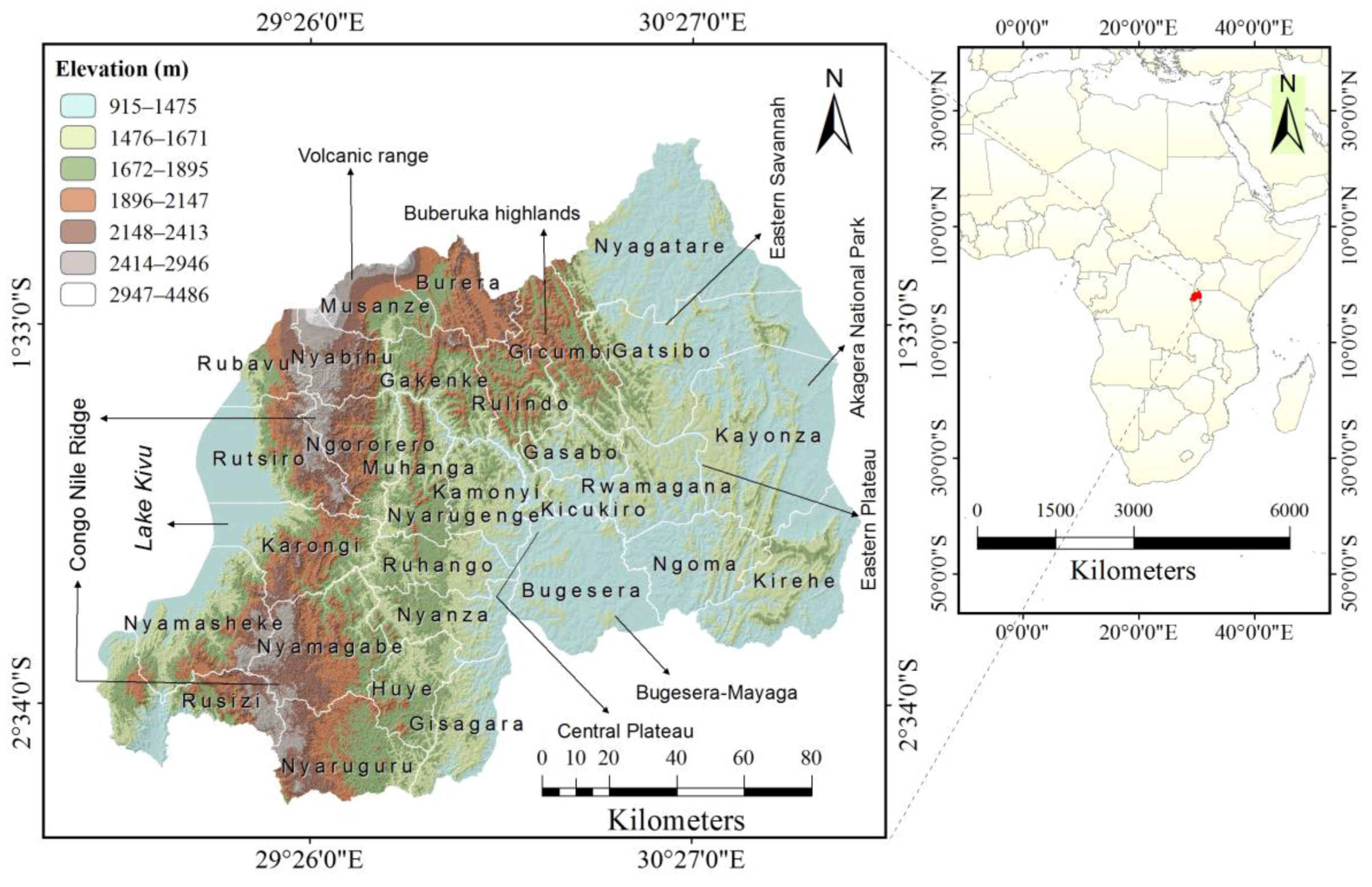
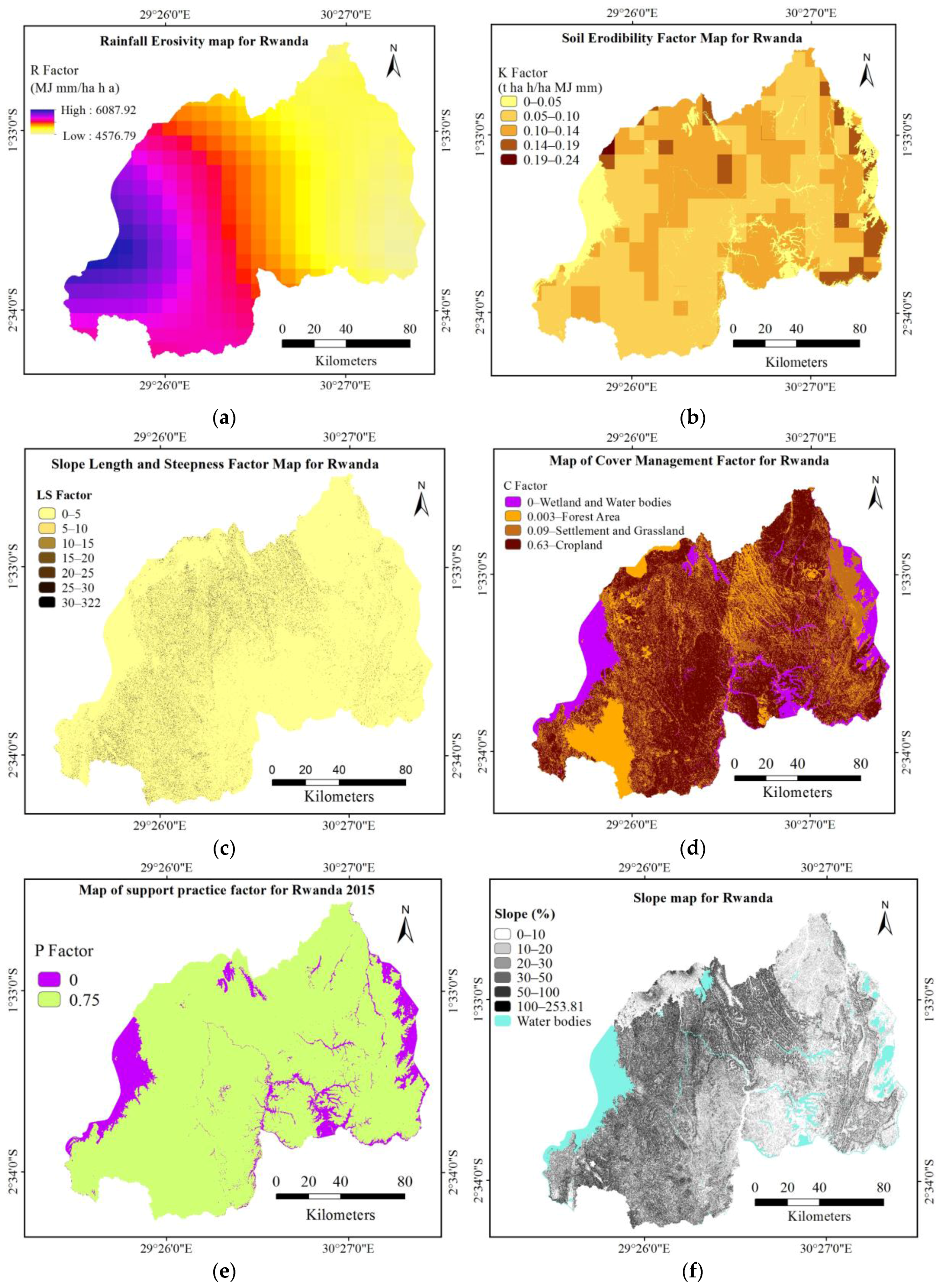
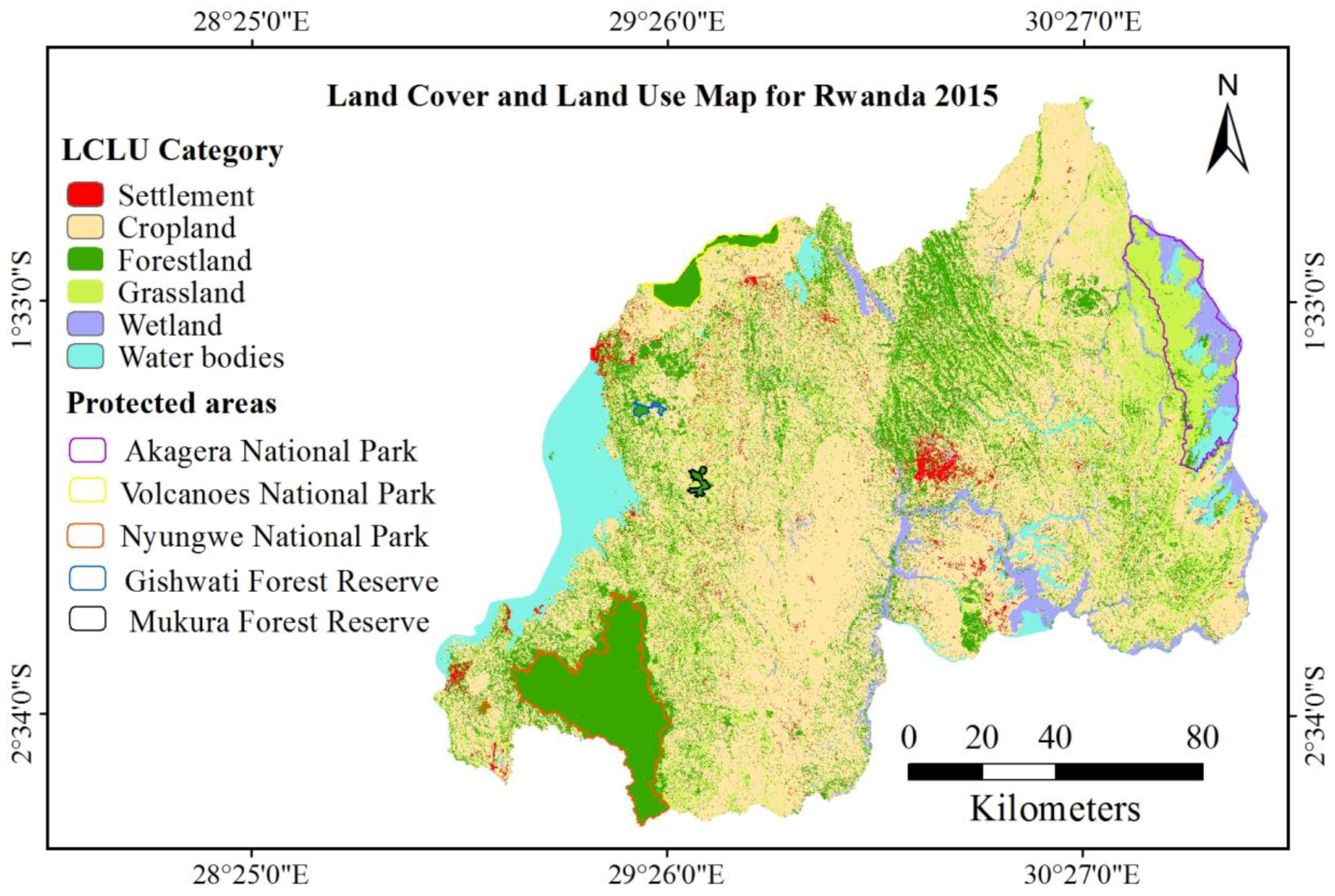
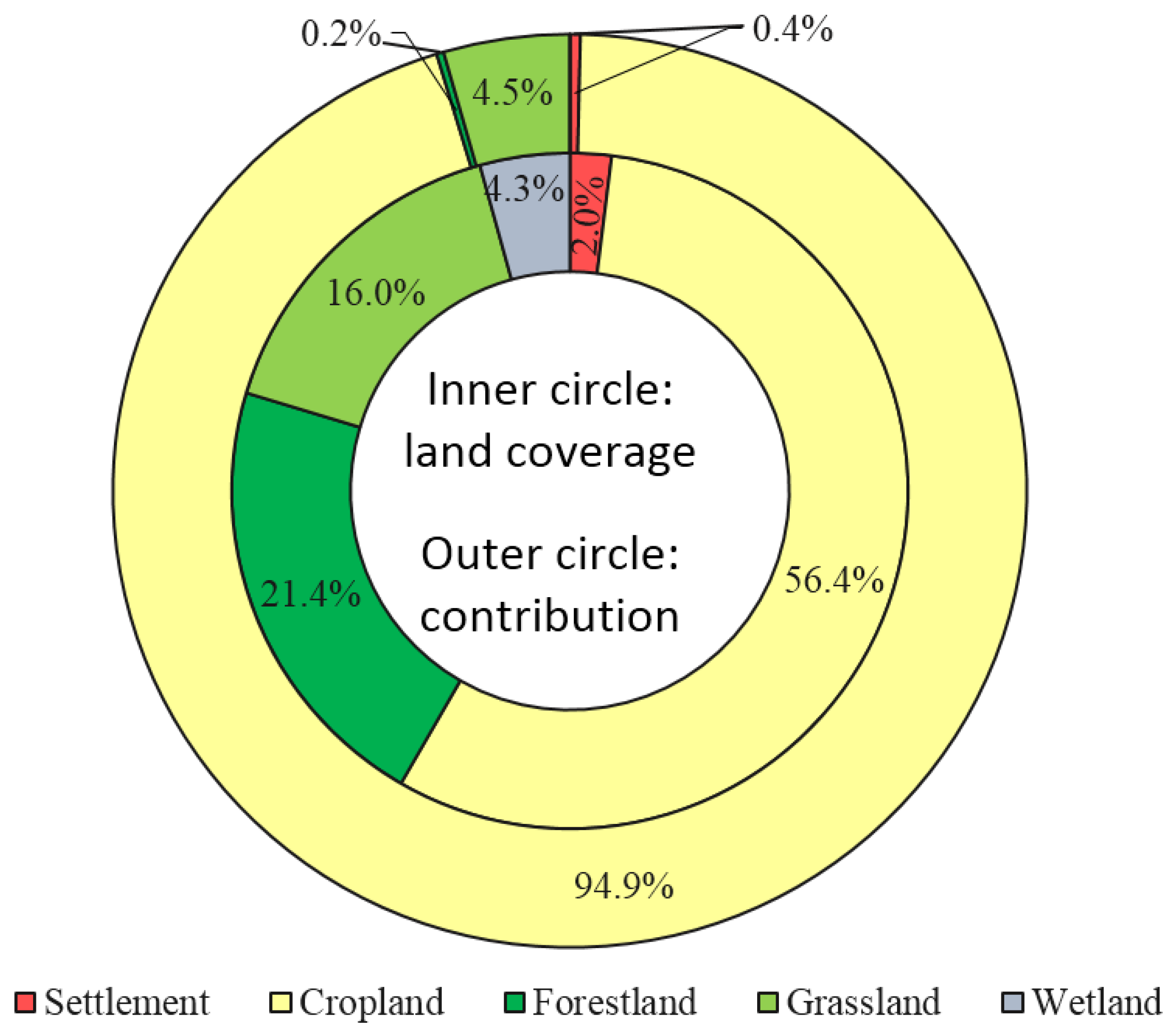
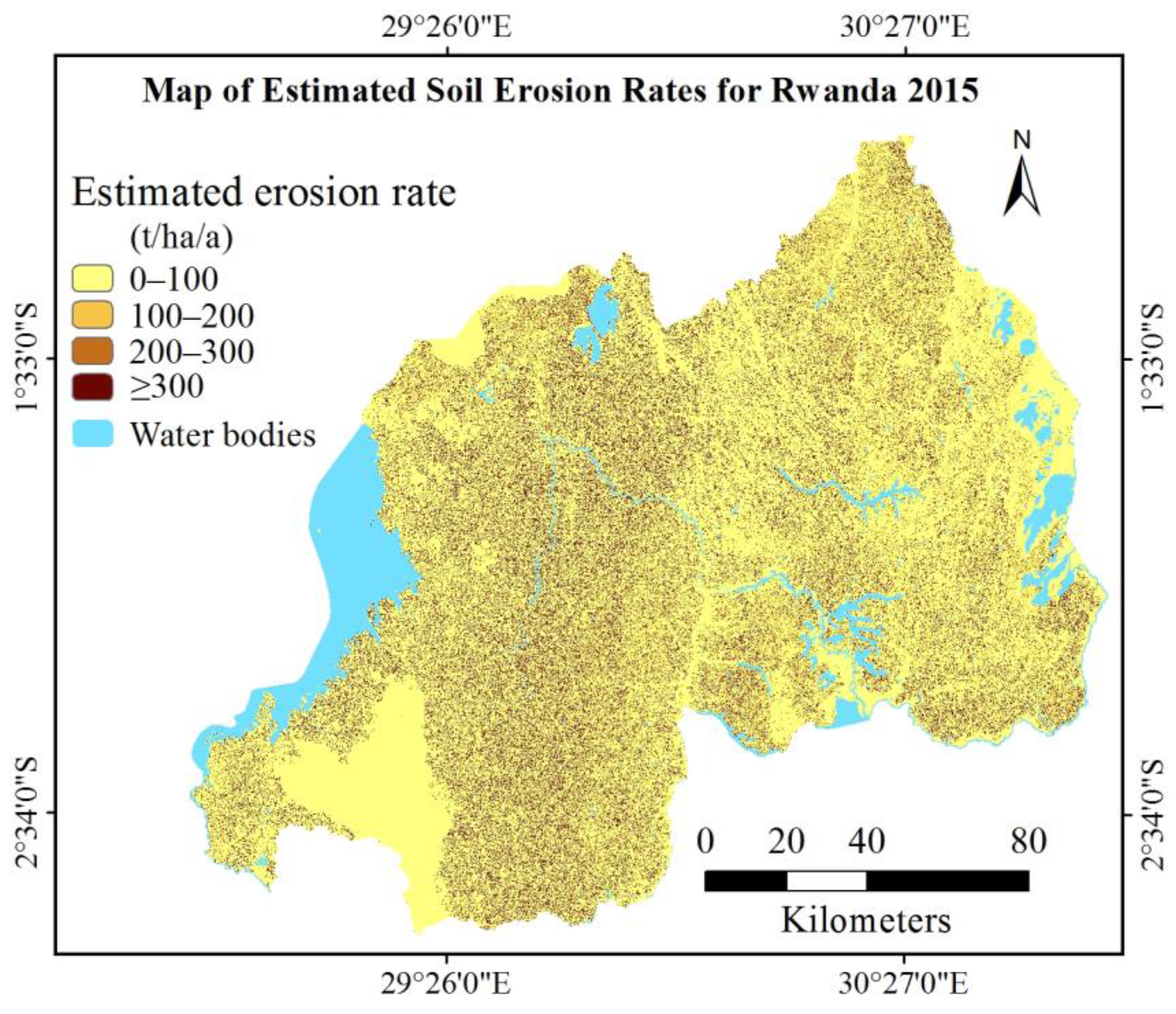
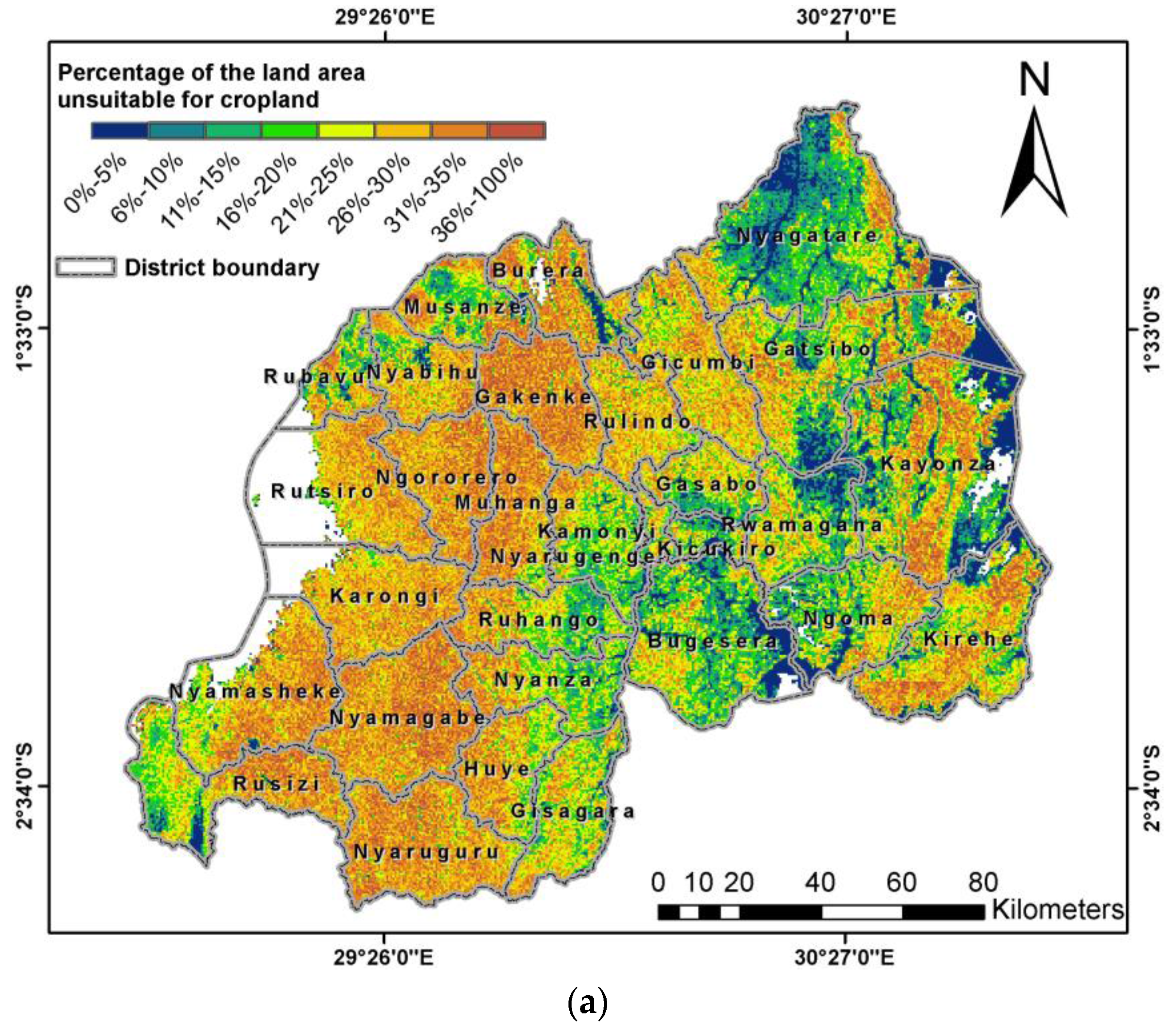
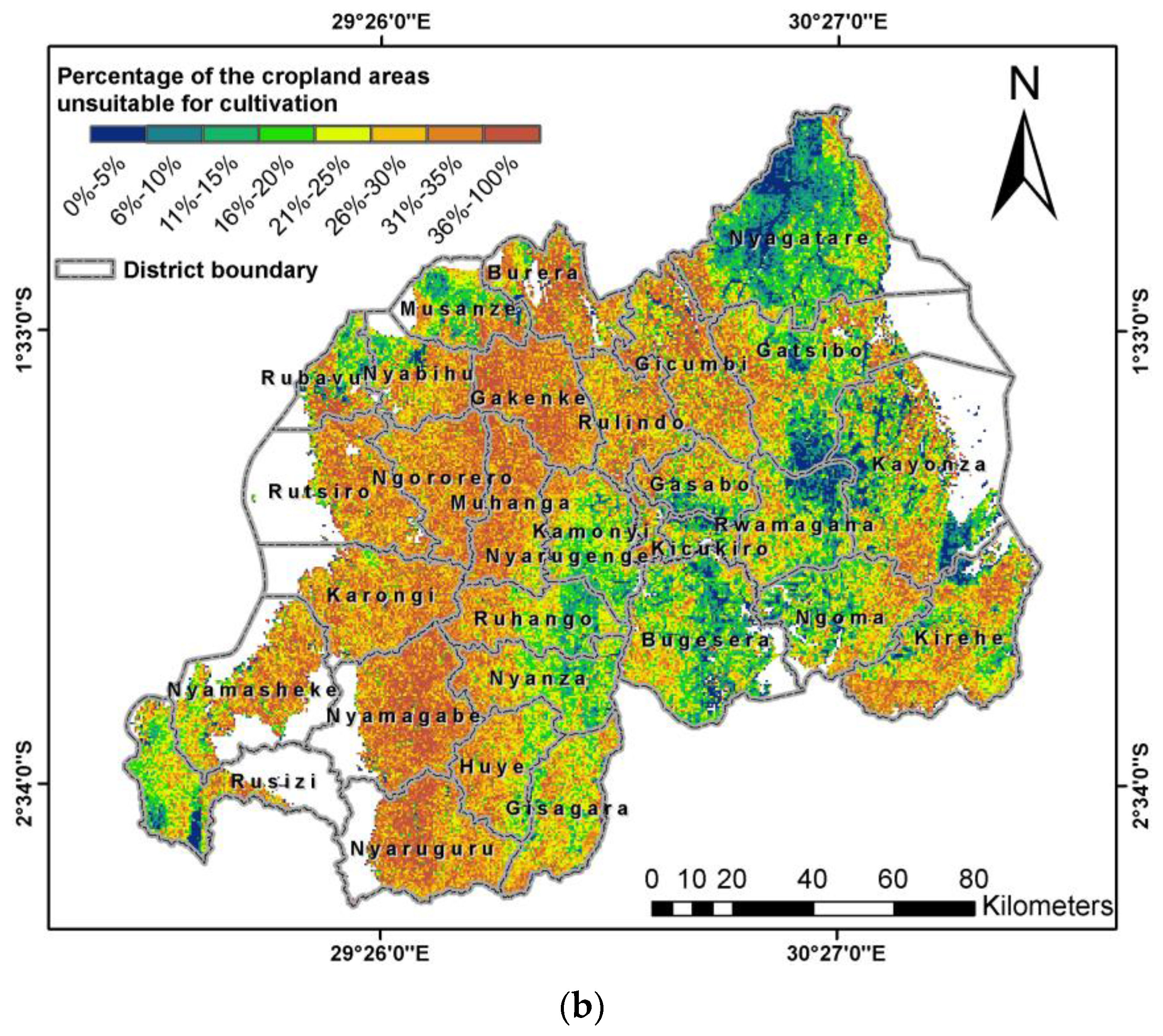
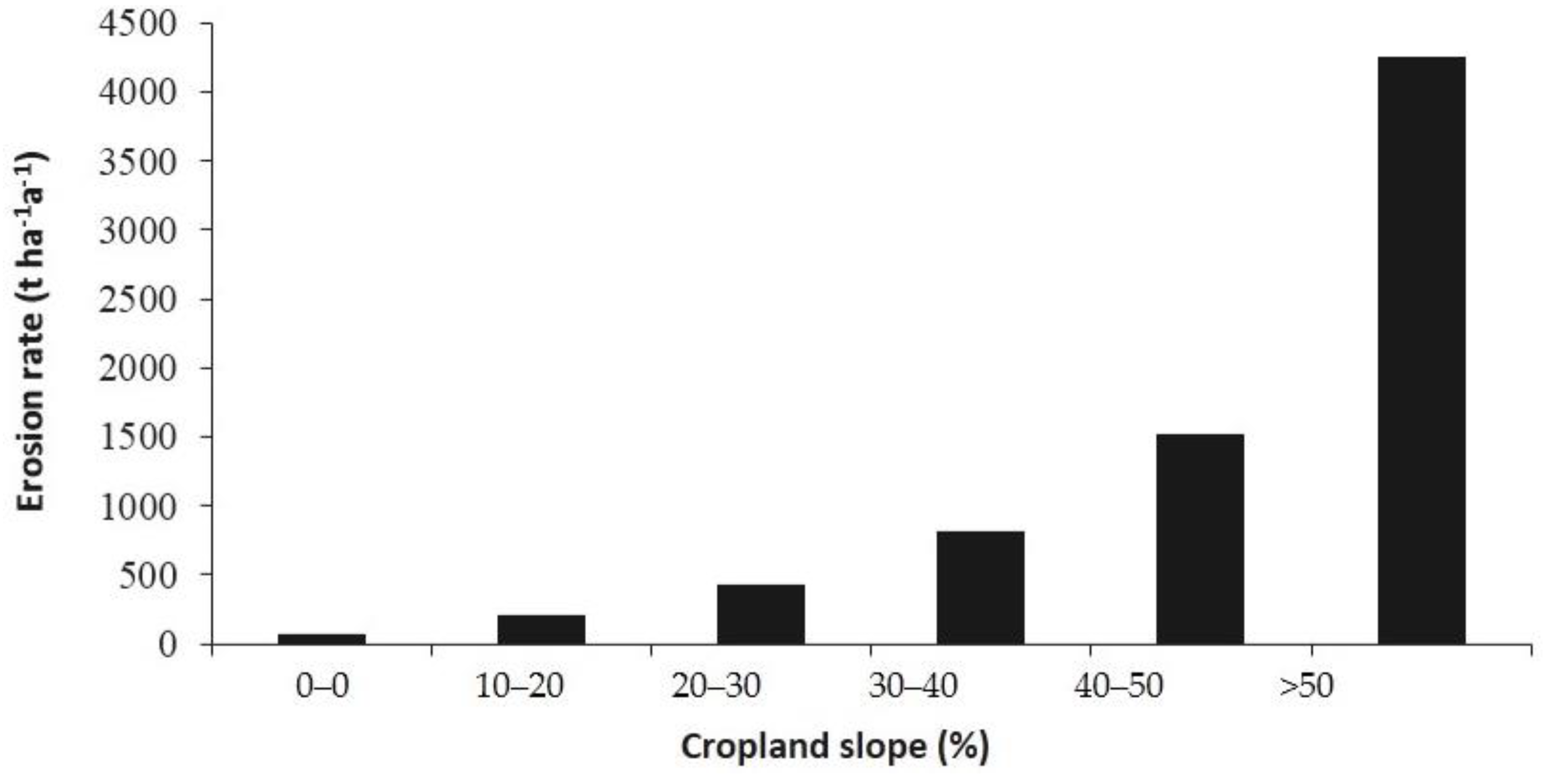

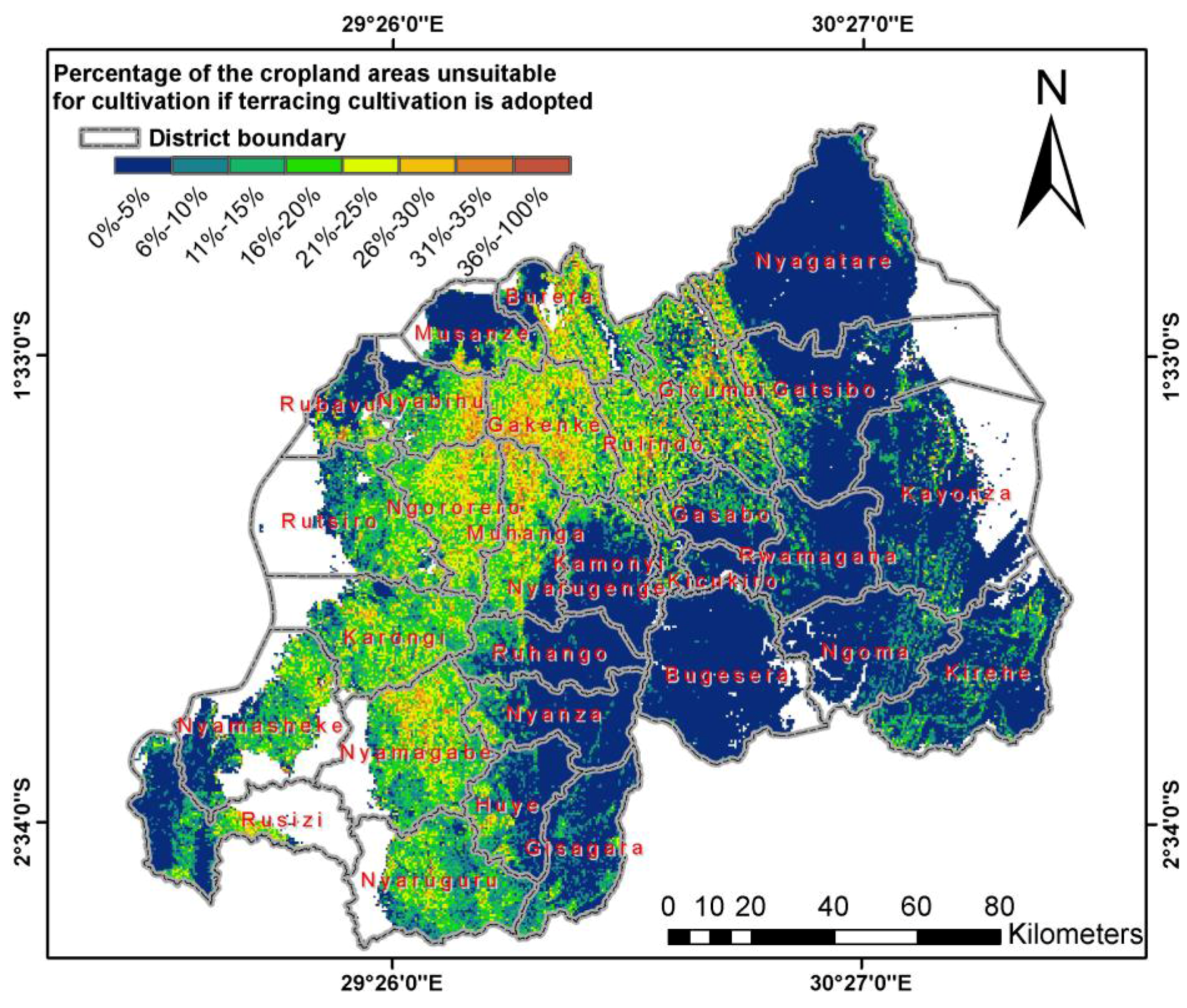
| Path | Row | Acquisition Date | Cloud Cover |
|---|---|---|---|
| 173 | 61 | 20 August 2015 | 7% |
| 173 | 62 | 20 August 2015 | 2% |
| 172 | 61 | 12 July 2015 | 0% |
| 172 | 62 | 12 July 2015 | 0% |
| Slope (%) | 0–7 | 7–11.3 | 11.3–17.6 | 17.6–26.8 | >26.8 |
| P factor | 0.1 | 0.12 | 0.16 | 0.18 | 0.2 |
| Data Type | Description and Source |
|---|---|
| R and K factors | Global rasters in TIF format from the Global Land Degradation Information System (GLADIS) database of the Food Agriculture Organization (FAO) [51]. |
| LS Factor | Derived from the Advanced Spaceborne Thermal Emission and Reflection Radiometer (ASTER) Global Digital Elevation Model (GDEM) Version 2 (30-m resolution) from the USGS Global Visualization Viewer (GloVis) [25]. |
| C Factor | Obtained by assigning the C factor values recommended by Kim et al., 2005 [47], to the LCLU map 2015 of Rwanda (Figure 3). |
| P Factor | According to the study of Nachtergaele et al., 2011 [18], the value was set to 0 for wetland and 0.75 for all other land types. |
| Classes | Producer’s Accuracy | Omission Error | User’s Accuracy | Commission Error |
|---|---|---|---|---|
| Settlement | 100% | 0% | 95% | 5% |
| Cropland | 87% | 13% | 98% | 2% |
| Forestland | 92% | 8% | 90% | 10% |
| Grassland | 96% | 4% | 86% | 14% |
| Wetland | 95% | 5% | 98% | 2% |
| Water | 100% | 0% | 100% | 0% |
| Districts | Area (103 ha) | Soil Erosion Rate (t·ha−1·a−1) | Annual Soil Loss (Million t) | Contribution to National Soil Erosion | Cropland Erosion Rate (t·ha−1·a−1) | Cropland Coverage | Fraction of Unsuitable Cropland |
|---|---|---|---|---|---|---|---|
| Gakenke | 70 | 678 | 48 | 8.0% | 999 | 65% | 6.5% |
| Ngororero | 68 | 610 | 41 | 6.9% | 871 | 67% | 6.1% |
| Muhanga | 64 | 533 | 34 | 5.8% | 720 | 72% | 6.0% |
| Rulindo | 57 | 500 | 28 | 4.8% | 933 | 52% | 2.7% |
| Karongi | 79 | 417 | 33 | 5.5% | 679 | 58% | 5.3% |
| Burera | 59 | 413 | 24 | 4.1% | 740 | 54% | 2.9% |
| Nyabihu | 54 | 400 | 21 | 3.6% | 700 | 55% | 2.1% |
| Nyamagabe | 109 | 370 | 40 | 6.8% | 748 | 47% | 7.6% |
| Rutsiro | 66 | 310 | 20 | 3.5% | 542 | 55% | 4.2% |
| Huye | 58 | 307 | 18 | 3.0% | 357 | 83% | 5.5% |
| Nyaruguru | 101 | 300 | 30 | 5.1% | 557 | 51% | 7.8% |
| Gicumbi | 83 | 267 | 22 | 3.7% | 687 | 36% | 1.8% |
| Musanze | 51 | 244 | 12 | 2.1% | 403 | 59% | 1.6% |
| Ruhango | 63 | 240 | 15 | 2.5% | 263 | 90% | 4.6% |
| Nyanza | 67 | 210 | 14 | 2.4% | 254 | 81% | 3.8% |
| Gisagara | 68 | 205 | 14 | 2.3% | 283 | 71% | 2.8% |
| Nyamasheke | 94 | 203 | 19 | 3.2% | 506 | 38% | 3% |
| Kamonyi | 66 | 202 | 13 | 2.2% | 243 | 81% | 3.3% |
| Rubavu | 34 | 176 | 6 | 1.0% | 335 | 48% | 0.8% |
| Kirehe | 115 | 175 | 20 | 3.4% | 303 | 53% | 4% |
| Gasabo | 43 | 172 | 7 | 1.2% | 329 | 50% | 0.7% |
| Rusizi | 91 | 152 | 14 | 2.3% | 377 | 39% | 1.9% |
| Nyarugenge | 13 | 140 | 2 | 0.3% | 380 | 34% | 0.2% |
| Rwamagana | 65 | 138 | 9 | 1.5% | 202 | 65% | 1.5% |
| Ngoma | 81 | 135 | 11 | 1.8% | 218 | 58% | 1.6% |
| Gatsibo | 155 | 134 | 21 | 3.5% | 269 | 44% | 3% |
| Nyagatare | 191 | 126 | 24 | 4.1% | 175 | 68% | 3.3% |
| Bugesera | 121 | 105 | 13 | 2.1% | 158 | 65% | 3.3% |
| Kicukiro | 17 | 100 | 2 | 0.3% | 188 | 50% | 0.3% |
| Kayonza | 178 | 94 | 17 | 2.8% | 222 | 33% | 1.8% |
| Rwanda | 2380 | 250 | 595 | 100.0% | 421 | 56% | 24.4% |
© 2016 by the authors; licensee MDPI, Basel, Switzerland. This article is an open access article distributed under the terms and conditions of the Creative Commons Attribution (CC-BY) license (http://creativecommons.org/licenses/by/4.0/).
Share and Cite
Karamage, F.; Zhang, C.; Ndayisaba, F.; Shao, H.; Kayiranga, A.; Fang, X.; Nahayo, L.; Muhire Nyesheja, E.; Tian, G. Extent of Cropland and Related Soil Erosion Risk in Rwanda. Sustainability 2016, 8, 609. https://doi.org/10.3390/su8070609
Karamage F, Zhang C, Ndayisaba F, Shao H, Kayiranga A, Fang X, Nahayo L, Muhire Nyesheja E, Tian G. Extent of Cropland and Related Soil Erosion Risk in Rwanda. Sustainability. 2016; 8(7):609. https://doi.org/10.3390/su8070609
Chicago/Turabian StyleKaramage, Fidele, Chi Zhang, Felix Ndayisaba, Hua Shao, Alphonse Kayiranga, Xia Fang, Lamek Nahayo, Enan Muhire Nyesheja, and Guangjin Tian. 2016. "Extent of Cropland and Related Soil Erosion Risk in Rwanda" Sustainability 8, no. 7: 609. https://doi.org/10.3390/su8070609
APA StyleKaramage, F., Zhang, C., Ndayisaba, F., Shao, H., Kayiranga, A., Fang, X., Nahayo, L., Muhire Nyesheja, E., & Tian, G. (2016). Extent of Cropland and Related Soil Erosion Risk in Rwanda. Sustainability, 8(7), 609. https://doi.org/10.3390/su8070609







